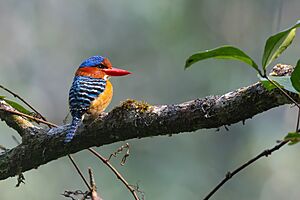Banded kingfisher facts for kids
Quick facts for kids Banded kingfisher |
|
|---|---|
 |
|
| A male, in Sumatra, Indonesia | |
 |
|
| A female in Thailand | |
| Conservation status | |
| Scientific classification | |
| Genus: |
Lacedo
|
| Species: |
pulchella
|
| Subspecies | |
|
|
The banded kingfisher (Lacedo pulchella) is a colorful bird found in the warm, wet forests of Southeast Asia. It's a type of tree kingfisher, which means it lives mostly in trees, unlike some kingfishers that prefer water. This bird is the only one in its group, called Lacedo.
What makes these birds special is how different the males and females look. The male has bright blue feathers on its head and back, with cool black and blue stripes. The female, however, has reddish-brown and black stripes on her head and upper body.
Contents
What's in a Name?
The banded kingfisher was first officially described in 1821 by an American scientist named Thomas Horsfield. He gave it the scientific name Dacelo pulchella. Later, in 1851, a German bird expert, Ludwig Reichenbach, put it into its own group, Lacedo.
The name Lacedo is actually a mix-up of Alcedo, which is the Latin word for kingfisher. The second part of its name, pulchella, is Latin for "very pretty." So, its full scientific name basically means "pretty kingfisher"!
There are three slightly different types, or subspecies, of the banded kingfisher:
- L. p. pulchella: This type lives in Malaysia (south of 7°N latitude) and on the islands of Sumatra and Java.
- L. p. amabilis: You can find this one from northern Malaysia and further north. It's a bit bigger than the pulchella type. The male has a blue patch on the back of its neck, and the female looks more reddish-brown.
- L. p. melanops: This type lives in Brunei. The male has a black forehead, cheeks, and the back of its neck.
What Does It Look Like?
The banded kingfisher is about 20 centimeters (8 inches) long. It has a strong, red beak and a short crest of feathers on its head that it can slowly raise and lower.
Male and female banded kingfishers look very different, which is unusual for many birds.
- The adult male has a reddish-brown forehead, cheeks, and the back of its neck. Its cap is a bright blue. The rest of its upper body, wings, and tail are black with blue stripes. Its chest, sides, and under-tail feathers are reddish-brown, and its central belly is white.
- The adult female is just as eye-catching. She has black and reddish-brown stripes on her upper body. Her underparts are white, with some black stripes on her chest and sides.
Young banded kingfishers are not as brightly colored as the adults. They have a brown and orange beak and some dark stripes on their underparts.
When it calls, the banded kingfisher makes a long, whistling sound like wheeeoo. This is followed by about 15 quick chiwiu sounds, where the second part of the sound slowly fades away. If you try to copy its call, it might even respond!
Where Do They Live?
These beautiful birds can be found in several countries in Southeast Asia. This includes Myanmar, Thailand, Cambodia, Vietnam, Laos, Malaysia, Sumatra, Java, and Brunei. Sadly, they are no longer found in Singapore.
How Do They Behave?
The banded kingfisher lives in lowland rainforests. In Brunei, they can be found up to 1,700 meters (about 5,500 feet) high. However, in most other places, they prefer to stay below 1,100 meters (about 3,600 feet) in altitude. Unlike most kingfishers, they don't need ponds or streams nearby to live happily.
These birds build their nests in holes they dig in rotting tree trunks. Sometimes, they even use the round nests of tree termites! A female banded kingfisher usually lays two to five white eggs. In Thailand, they typically lay their eggs between February and May.
The banded kingfisher mostly hunts large insects. Sometimes, it will also catch small lizards. They usually find their food in the trees, but they might also pick up a meal from the ground.
What's Their Status?
The banded kingfisher is not very common, but it is spread out across much of its home range. It is quite rare in Java and very rare in Sumatra. As mentioned, it has completely disappeared from Singapore.


